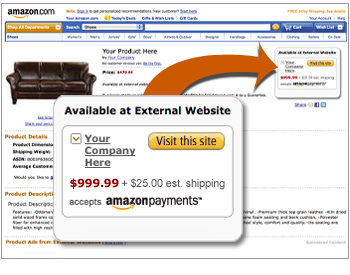With 1.5 million visitors per day, the Amazon marketplace offers a great opportunity for SMB online retailers to gain exposure. But how exactly do you use Amazon to grow your business? Here are two approaches –
Product ads by Amazon – This works very similar to Google adwords. You display pay-per-click advertisements in the product pages of Amazon.com. For example, if you are selling furniture, then Amazon will display advertisements for your product in the product pages of similar furniture from other vendors. So, once the customer narrows down to the exact product that she wants, Amazon is displaying your information right there on that page with your price information (see image below), and the customer can reach your webstore in just one click. The order transaction occurs on your website, and therefore there are no additional fees that Amazon charges you. 
Sell on Amazon.com – In this approach, you are listing your products on the Amazon marketplace, and the order transaction happens through Amazon.com. Products from your inventory are listed side-by-side with the products from Amazon’s own inventory. Once the customer completes the purchase, Amazon notifies you and lets you fulfill the order. But since the order was captured on the Amazon.com site, they will charge you a percentage of the product price and additional fees for the item that sells.
So, what are the main differences between “Product Ads” vs “Selling on Amazon”?
- Product Ads drive traffic to your own website outside Amazon. Whereas “Selling on Amazon” lets the customer buy your product without ever leaving the Amazon website
- Product Ads require you to deal with the credit card transaction on your website. “Selling on Amazon” takes care of the credit card transaction on its own
- Product Ads let you control the customers’s buying experience because they are on your website. “Selling on Amazon” gives you no control over the customers’s buying experience
- Products Ads charge you a cost-per-click – in other words, you are buying targeted traffic from Amazon. “Selling on Amazon” charges you cost-per-action – in other words, they charge you a percentage of your order sale price and an additional fee for that order
Even though these are two different approaches, you can combine them to expose your entire product catalog to the millions of shoppers on the Amazon.com website.
